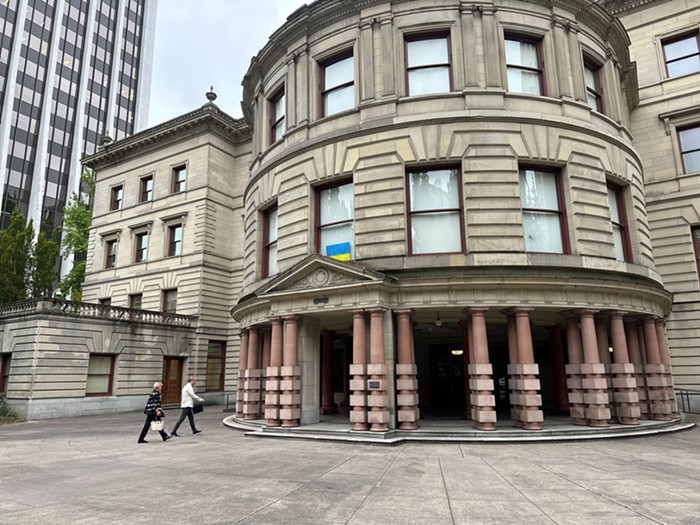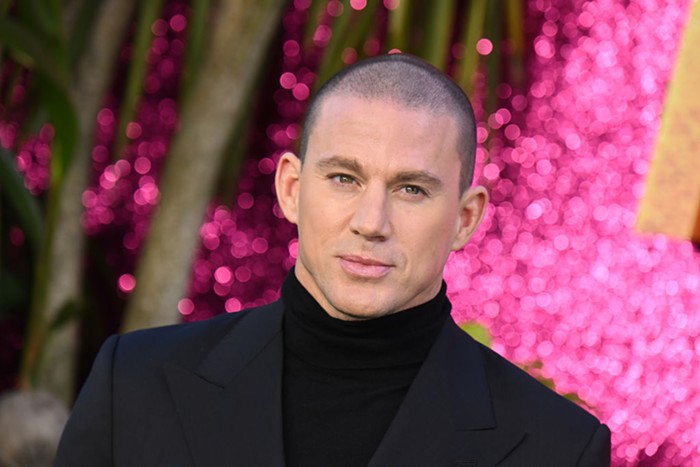It wasn't long before the traders' befuddlement led to gleeful acceptance, after realizing Qangon would be one hell of a qualified trapping guide to the interior's abundant natural resources. For the next 25 years, she worked as a professional Columbia and Snake Rivers guide, trapper, courier, and is still honored by the Kootenai people as a "warrior, prophetess, and peacemaker." During that time, between blazing trapper trails and living Kootenai tribal life she, in effect, walked between two worlds.
Qangon was a lesbian berdache, or Two-Spirit, and she wasn't alone. Historians say gay and lesbian Two-Spirits have existed in nearly every aboriginal culture, including virtually all North American aboriginal tribes. Two-Spirits were the trendsetters, the songwriters, the vanguard ambassadors to other cultures. Because they were considered to have a spiritual "foot in two worlds," Two-Spirits presided over conflict resolutions, acted as couples' counselors, and were prized as the best of shamans.
Conversely, invading forces were traditionally offended. During early Pueblo missionary invasions by Franciscan monks for example, the simple fact that sexuality of any kind was openly displayed among natives caused unimaginable moral discomfort for the pompous priests. The Pueblo Indians were equally disgusted at the priest's celibacy, and viewed them as only "half-persons."
To Be A Two-Spirit Today
Recently, there has been a rekindling of Two-Spirit traditional practices, but the effort has not been without the slings and arrows of controversy. The renowned gay visionary and theoreticist Harry Hay (along with partner John Burnside) conducts Spirit Gatherings, Sex Magic workshops, and "faerie circles" in Wolf Creek Oregon, and is one of the "creating forces" of the modern Two Spirit traditions resurrection. Hay has been called the "undisputed elder of the gay and lesbian community." He made history in 1951 when he co-founded the Mattachine Society in Los Angeles (one of the first gay organizations in the United States), and is considered to be a founding father to the modern gay liberation movement. "We face many barriers in working to realize our vision," Hay says. "AIDS, sexual addiction, objectification, ageism, lookism, internalized heterosexism, unrealistic expectations. These issues loom large as we begin this crucial step in manifesting our collective faerie vision--the ritual realization of Subject-Subject consciousness."
One respected Two-Spirit scholar and contemporary historian, a friend and associate of Harry Hay, is author Bo Young. Also the biographer of Clyde M. Hall (Shoshone medicine elder and tribal magistrate), Young has extensive experience and knowledge regarding this particular subject. As a former therapist and counselor, Young has studied with Hall for 10 years in Idaho and Montana, has been a Naraya dancer, participated in Sweat Lodge, Pipe, Feeding of the Dead, Vision Quest, Shoshone Warm Dance, Sacred pipe bundle openings with the Blackfeet people, and other Native American and Amazonian ceremonies.
According to Young--a bespectacled 51-year-old Brooklynite--Two-Spirit refers to "third gender individuals who function in culture as 'bridge people,' or someone who and 'walks betweens' male and female worlds."
Young says the term was coined to encompass the many different names individual tribal nations had and have for these individuals within their own cultures. "It may or may not refer to someone's sexuality and should not be used as a synonym for 'gay' or 'homosexual.' It is meant to reflect a social position, not a sexual orientation." He says the term was coined less than 10 years ago at a meeting of gay and lesbian Native American anthropologists meeting in Washington D.C., to establish an English word that conveys the "various historical meanings to a modern world."
Two-Spirit was also devised to help counter the existing, historically-used title, berdache, the post-colonialism French/ Persian term for those who engage in same-sex relationships. Young believes the origins of the term berdache reflect "a total inability to understand the culture and the individuals they first encountered in these tribes. But it was the only way the Western European missionary mind could understand what they were observing (and, with typical Christian fervor, killing off, too, by the way.)"
Socially Sanctioned, Sacred Sex
While Two-Spirited people did and do have sexual relations with members of their own sex, Young is quick to offer a broader perspective. "It would be a mistake to characterize these individuals solely by virtue of their sexuality, though it was often a facet of their social existence. These individuals were seen as mediators, healers, shamans, teachers, culture-carriers, and counselors. Sexual relations would happen in the shamanist tradition of 'gifting' such a person. But the important idea is that the social distinction was a part of a larger social role, and the sexuality was a small, albeit important, part of the picture."
He compares Two-Spirit traditions with those of ancient Greece, where "men had women for the purpose of procreation and had berdache lovers for love or spiritual reasons. In many cultures which considered sexual intercourse a method of communication with their god or gods, same-sex-identified men served as sacred whores, as did heterosexual women. Many of the Great Plains chiefs were known to have berdache 'wives,' for example, and berdache were often brought along on hunting and warring parties because they were considered to lend a certain dignity and good blessing on the proceedings.
"There were both male and female Two-Spirits, the men usually taking on the social roles of women and the women generally taking on the social roles of men, including having wives and serving as warriors." Young adds that berdache warriors were often known to be "among the strongest fighters in some tribes."
Masters of Protocol, Refinement, and Culture
"All this notwithstanding," Young insists, "the Two-Spirit people of history are indeed our ancestors as gay and lesbian people, and there are many other instances in other cultures of same-sex people serving in similar roles in very different cultures. In fact, it is my own contention that modern gay and lesbian people continue to serve in these historical roles of mediation, in-between-ness, and as culture-carriers."
In Native American spiritual traditions, crossroads are considered to be sacred, or in-between places where the great Spirit of the world is most accessible. Any crossroad was considered to have a special connection to Spirit. Berdache were considered to be a place, a gender in between the two visible sexes, and were considered to possess unique gifts as a result. The Berdache were considered essential to any ritual or ceremony. They were thought to be the finest teachers, craftspeople, healers, musicians, and dancers.
The berdache were either ceremonially identified in early puberty, often in "Basket and Bow" ceremonies, or would 'self identify' later in life as a result of a dream or vision quest. During the Basket and Bow ritual, the child would be given a choice between a basket and a bow, which represented feminine and masculine powers, respectively. Young maintains the berdache would live apart from the greater village, in "the nicest of accommodations," and would have sexual relations only with the members of the tribe, not with each other.
"They were considered to be third, and possibly fourth genders, reflecting a much more sophisticated and broader understanding of human sexuality. If, in the meandering of the nomadic tribes, one tribe would encounter another, it would be the berdache who would be sent out to meet and greet the other group so as to negotiate the niceties and protocols of the larger groups meeting. They were the ambassadors and masters of protocol, refinement, and culture."
Homosexuality: Spiritual Ace in the Hole
When asked if he believes homosexuals have a spiritual advantage over heterosexuals, Young responds cautiously at first, "I think 'advantage' is the wrong word. Do roses have an advantage over lilacs? I think the point is that, despite the great lies which we have been fed since we were children, same-sex-identified individuals have a spiritual role in the world... and that it is different from but every bit as essential as the spiritual role of heterosexual people." Even so, Young admits he thinks homosexuals may be "THE" spiritual people of the world.
"Since heterosexual people must be concerned with populating the planet, it may well be the concern of homosexual people to civilize it. Within the confines of Native American spirituality, Two-Spirited people were considered to be 'adepts' in the spiritual world as a natural component of their soul. If the purpose of heterosexuality is the continuation of the gene pool, then the purpose of homosexuality is to make sure it is Olympic-sized with nice tile and plenty of lanes, and with nice terry cloth towels for everyone."
Trial by Fear
Unfortunately, although Two-Spirit traditions have survived and still seem to be evolving, there is a perceived rift between the Native and Non-Native Two-Spirit camps. The June 1997 Pride Issue of Village Voice features an article by F. Thomas Edwards, which argues a separatist vision, demanding "a safe space" for Native American Two-Spirits to assemble free from white "imperialistic control freaks."
Bo Young and mentor Clyde Hall acknowledge the rift, but don't accept it. "There is a fear among Native Two-Spirits of Americans," Hall has said, "white Americans getting in and controlling the way the Two-Spirit movement or tradition is moving. I don't agree, because right there these people are labeling basically saying that people of other races, other than Native American and Two-Spirited Native Americans cannot be trusted."
Young insists that from a gay and lesbian point of view, there is a "prima facie racism" in saying that people can't do this because they are white. He finds it distressing that spirituality is something that strengthens individuals and communities, yet there are Native American Two-Spirits, "who would deny gay brothers and sisters access to a history, to a tradition that would empower us all." By some accounts, Young would fall into the "Non-Native" category.
"The dominant culture loves for oppressed peoples to believe that there's not enough to go around. Keeps us busy arguing with each other and we don't have time to confront the real problems."
Which brings up the usual controversy. Not only is there a rift between Native and Non-Native Two-Spirit people, many "straight" Native Americans take a familiar post-colonialism posture (see Missionary Position), and wish the Two-Spirits would shut up and go away altogether.
Hall believes, even though there is a long-standing tradition of Two-Spiritedness among Native American tribes, and that Two-Spirits once enjoyed set and honored roles in tribal structure, "Nowadays, they don't have that role."
"I (will) always remember when Randy Burns and the group out in San Francisco established Gay American Indians, and I think they're celebrating something like their 25th anniversary. They set up their little table with their information on gay and lesbian activities and information on things, and a lot of the Indian people wouldn't accept it. They'd say, 'Oh, you people are an embarrassment. Why don't you leave?' and they'd spit on you and cuss at you. And that was from our own people! That homophobia still pervades most reservations. It isn't 'hello la-la land' out there."
Bo Young is quick to note that any current Native American bigotry against gays and lesbians is a direct and lingering result of post-colonialism's cultural destructive influence. He believes anti-homosexual sentiments have been shoved down their throats.
"It should come as no surprise what a chilling effect mass genocide can have on a cultural institution," Young attests. "The berdache, as the culture keepers, were among the first people murdered and worked to death when the white man arrived. Men dressing in women's clothing were a horror to the maniacal missionaries, hell-bent on saving souls for Jesus. These natives were killed when they refused to change their ways or dresses.
"Indians learned their lessons well, and like many prisoners and oppressed peoples adapted to the ways of the oppressor as a survival strategy. As a result, there are many Indians today who may have never heard of berdache and, if they have, might even deny that it existed in their tribe."












